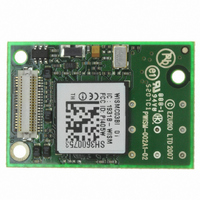WISMC03BI Laird Technologies, WISMC03BI Datasheet - Page 18

WISMC03BI
Manufacturer Part Number
WISMC03BI
Description
MODULE LAN 802.11B/G BISM
Manufacturer
Laird Technologies
Series
EZURiOr
Specifications of WISMC03BI
Frequency
2.4GHz
Data Rate - Maximum
1Mbps
Modulation Or Protocol
802.11 b/g
Applications
AMR, Automotive, ISM
Power - Output
15dBm
Sensitivity
-86dBm
Voltage - Supply
3.3 V ~ 5.5 V
Current - Transmitting
250mA
Data Interface
Connector, 50 Pin, DF-12
Memory Size
64Mbyte Flash, 16MByte SRAM
Antenna Connector
U.FL
Operating Temperature
-40°C ~ 85°C
Package / Case
Module
Wireless Frequency
2.412 GHz to 2.484 GHz
Interface Type
UART
Board Size
22.8 mm x 33.8 mm x 7.6 mm
Modulation
BPSK, CCK, DSSS, QPSK
Security
WEP 64/128, WPA-PSK, WPA2, TKIP, AES-CCMP
Lead Free Status / RoHS Status
Lead free / RoHS Compliant
Current - Receiving
-
Lead Free Status / Rohs Status
Lead free / RoHS Compliant
WISMC03BI
Wireless LAN Module / Device Server
APPLICATION
INFORMATION
18 www.lairdtech.com
ExTERNAL ANTENNA
The approval of the module was performed using a 3dBi external antenna from RF Castle Electronics
(www.rfcastle.com/pdf/RF-3dbi%20DipoleA.pdf). The antenna was connected using a short cable to
convert from the U.FL connector on the module to a reverse SMA. The conditions of approval allow the
use of an alternative antenna, but require that the resulting effective radiated power does not exceed
that exhibited during the approvals testing.
To ensure that the approval is not affected, the TOTAL GAIN of the external antenna, including insertion
loss of the connectors and cable must be less than 3dBi. If a higher gain is employed, then the pre-approved
status of the module will be lost. Customers must also ensure that the frequency characteristic of their
antenna matches that of the antenna used for approval. As antennae are tuned for their frequency band
the use of a different antenna technology may result in a change in emissions outside the 2.4GHz band.
It is the customer’s responsibility to ensure that an external antenna does not negate the approval.
U.FL connectors are supplied from a number of connector manufacturers. Details of Hirose’s mating
U.FL connectors are available at http://www.hirose.co.jp/cataloge_hp/e32119372.pdf
POWER SUPPLY CONSIDERATIONS
The power supply for the Module must be a single voltage source within the range of 3.3 V to 5.0 V.
It must be able to provide sufficient current for a transmit burst. This can rise to 550mA.
The Module includes on-board regulators to provide local 3.0V. This rail is accessible on pin 27 for
monitoring purposes only. Under no circumstances should this pin be used to source current.
Power (VCC_5V) is provided via the board-to-board connector Pins 28, 29 and 31. All VCC_5V and
GND pins should be connected to ensure that individual pin current capacities are not exceeded during
transmit current peaks.
POWER-ON-RESET
The Module is provided with an active high reset pin (Hirose 40way DF12C connector pin 13). However,
on the application of power, the Power On Reset circuit built into the Module will ensure that the unit
starts correctly. The external reset signal allows the module to be reset under software control from the
host. After a power on or reset operation, the module will de-assert the UART_RTS output and re-assert
it when it is ready to receive commands.
OPERATIONAL TEMPERATURE
The Wireless LAN module is designed to meet an operational temperature of -40°C to +85°C in normal
operation where it is running in IEEE power save mode.
If the module is run in a mode that results in more frequent receive and transmit activity the operating
temperature will need to be derated to ensure that overall module power dissipation limits are not exceeded.
When the ambient temperature rises above 60°C the module should only be operated in powersave mode
1 or higher.
The Wireless LAN module can operate in temperatures as low as -40°C, but the cold start minimum
temperature must not be below -25°C.
Laird Technologies

















